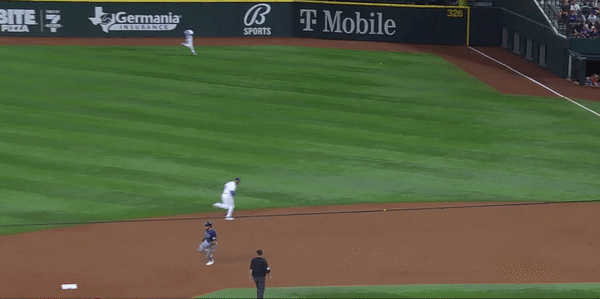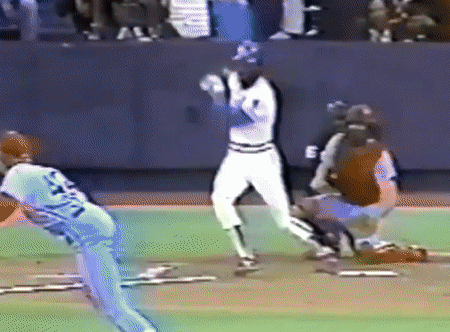It's Tag. They Should Shoot It That Way.
A thrilling play and the best camerawork of the season.
A couple weeks ago, with Josh Lowe on first base, Manuel Margot doubled to the right-field corner, unleashing a sequence of real-time questions the viewer might have:
How trickily would the ball bounce off the angled wall,
Would right-fielder Adolis García field it cleanly,
Would Josh Lowe run without stumbles,
Should they send Lowe home!?!?!?,
Would they send Lowe home,
Would García’s throw to the relay man be strong and online,
Would cut-off man Marcus Semien’s relay throw be clean, quick, strong and accurate,
Would Margot stop at second or keep going to third,
Would catcher Jonah Heim avoid illegally blocking the plate,
Would Lowe beat the throw, and/or
Would Lowe evade the tag?
In one video, the best-shot clip of baseball I’ve seen all year, shown in real time with the home broadcaster’s voice rising into a swell, we got the answers to all of those:
Do yourself a favor—don’t just watch my janky GIF. Here’s the clip of the home broadcast in better resolution, with broadcast audio, so you can really see it.
This is a tour de force. By first pulling back and then zooming in, the camera displays the field on four different scales, while in sequence introducing us to the four supporting characters who pop in to advance the plot—
1— Lowe & the Right Fielder (Outfield Shot)
2—Lowe & the Base Coach (Whole Field Shot)
3—Lowe & the Relay Man (Infield Shot)
4—Lowe & the Catcher (Batter’s Box Shot)
The camera smoothly journeys from way out in right field into a tight final showdown at the plate without ever letting Lowe out of the shot and without ever letting the ball out of the shot.
This is great for seeing all the tiny details of the play—how often do you get to see the third-base coach jogging past the lead runner, so he can get into position to signal the trail runner; how often do you get to see the precise moment that the runner’s galloping momentum finally shakes free the helmet; how often do you get to see the base umpires subtly repositioning themselves as the contours of the play develop; how often do you see the relay man racing over to get into position?—but it’s especially great for tension, and for giving the viewer a sense of participation in the play. I watched this live. From the moment García picked up the ball, my brain was whirring to calculate Lowe’s chances to score. As Lowe was two or three steps from third base, it felt like the decision of whether to send him home was mine! And I sent him! And I could feel the despair when, just as Semien was about to cut off García’s throw, my brain computer re-ran the numbers and concluded that very soon Lowe was going to be out. I’d made the wrong call :(
**
A good rule of thumb for how to shoot a baseball game is: A play should be shown in as few shots as possible; and each shot should show the runner, the ball, and the relevant fielder at the same time, if possible.
There have been something like a dozen runners thrown out at home on doubles to right field this year. I watched them, and the Lowe play is the only time we got this uninterrupted full-view shot live. (Sometimes it shows up in replays.) Normally, we get some variation of: Shot of the fielder chasing the ball; cutaway to a tight shot of the runner, who is… somewhere between bases, it’s always hard to tell where; then go back to the fielder throwing the ball (or having just thrown the ball) to the relay man. As the relay throw comes to the plate we just have to guess how close the runner is, and at the last second ball and runner abruptly meet at last. Many cuts, back and forth between isolated fielder and isolated runner.
The back-and-forth is so much the standard that, on the very same Josh Lowe play that this article is about, the visiting team’s broadcast did the back-and-forth:
No! Not like that! So much less useful than the home broadcast’s oner. Here you miss almost everything—you don’t even see García’s slight bobble, because the camera is instead showing Lowe chugging along for eight uninformative steps—and you also lose the 11 seconds of tension that comes from seeing Lowe and the ball steadily converging at their final destination. There’s obviously still tension in the play. We know that a runner is going to be safe or out at the end of this, so we’re stimulated. It’s just that this is shown in a way that the resolution simply lands on us at the end. It’s like calling a hotline to find out if a coin landed on heads or tails.
Or, I guess, it’s like filming a game of tag without ever showing the chaser and the chased in relation to each other.
**
There’s nothing special about the camera location that captured Lowe’s run around the bases. There are high cameras in every park that can show the whole field, and that can show the whole infield plus half the outfield at the same time. The reason we got the Lowe shot is because the broadcast chose to give it to us.
Most broadcasts choose not to. The visual language preferred by broadcasts when a base hit goes to the outfield is to zoom in on the outfielder, to basically fly out past the infield and leave all of the baserunning behind. You can see it in this very typical play, from earlier this year, on a Michael Massey single that ends up with a play at the plate:
That sequence starts with, let’s call it Camera A. It ends with Camera A. The whole thing could have been shown with Camera A, unchopped, a race between ball and baserunner and we’d get to see the dang throw. But because Camera A had zoomed way out on the left fielder, the baserunner fell out of the picture. Then, trying to re-establish the second character in this two-character story, the broadcast did the cutaway shot to the runner, isolated who-knows-where between third and home. Both shots—the zoom on the fielder and the cutaway to the runner—are bad. They’re visual pablum. The pointless zoom necessitates the pointless cutaway, and then the cutaway in particular tells us nothing while obscuring everything else that’s happening. No more of that shot!
I suspect the zoom-on-the-outfielder became the visual language of the sport because, with more primitive broadcast technology, it was too hard to see clearly what was happening way out in the outfield. If you had tried to do the Josh Lowe shot in the 1980 World Series, I doubt that the home viewer watching an over-the-air broadcast on a 13-inch RCA would have been able to follow anything happening way out at the wall.
But cameras are better today, screens are better today, digital compression is better today, and in the Lowe play you can easily what’s happening in right field even from far away. (Again, it helps if you’re watching the clip and not just my GIF.) The camera doesn’t need to zoom in on García for us to see that he positioned himself well for the carom but bobbled the pickup.
But even back then the zoom didn’t have to be the default all the time. In the famous play of Sid Bream scoring to walk-off the 1992 NLCS, the camera starts to zoom in on the left fielder Barry Bonds—and then suddenly changes its mind and reverses, keeping Bream and Bonds in the frame. What a smart ad-lib! Because of that choice to keep Bream and ball in visual relation to each other, we get to see Bream reaching and rounding third base, and we thus get the right to scream “send him! send him!” The broadcast still does a (in my opinion ill-advised) cutaway to Bream, but because we never lost sight of Bream in the original shot we have a good idea of where he is in space. The cutaway isn’t as out of rhythm and it isn’t as disorienting, and, thankfully, it is very brief:
Unlike that bad Michael Massey GIF up above, in this one we can see Bream actually racing the ball down the third-base line, which is what makes the highlight so great (along with, of course, the stakes of the play and everything else).
So, to sum up:
They should quit zooming in on outfielders picking up the ball1. Keep back so the runner stays in the shot. Show more of the field, not less of it.
Cutaways to the runner are almost always pointless, often to the point of disorienting; make decisions that will minimize them.
Once the ball is in play, it’s tag. Tag is a game of either convergence or of pulling away, and the only way to capture this is to show the runner and the ball in relation to each other. At least, as much as possible.
I’m writing this piece in the style of an argumentative essay. But a) this is a niche subscription-only newsletter, not exactly the best way to persuade the masses, and b) I’m open to the possibility that this is harder than it seems, that there is a practical reason that broadcasts continually choose the most disorienting, least thrilling way to shoot exciting plays. So, if my argument is bad, then let me just at least say this: I appreciate that Josh Lowe play so, so much. I’m grateful I got to saw it, I was thrilled by it in real time, I immediately shared it with other baseball watchers who I knew would appreciate it. The best baseball moments of the year for me are legitimately 1) Ohtani/Trout in the WBC and 2) Josh Lowe racing home. Huzzah to the genius(es) who pulled it off. More like that, please.
I’ll note that they should also stop zooming in on the shortstop on ground-ball-double-plays. On what figure to be close plays at first, let us see the runner!













I want to send a special shoutout to the third base line sky cam thing in Seattle. I love watching games at that stadium because the way that camera shows the choreography on the field is unparralled. It should be mandatory in every park.
Niche or not, I am hoping someone with some connections gets this message across to an announcer and/or a broadcast director, because Sam you are so so right. That wide shot is incredible!